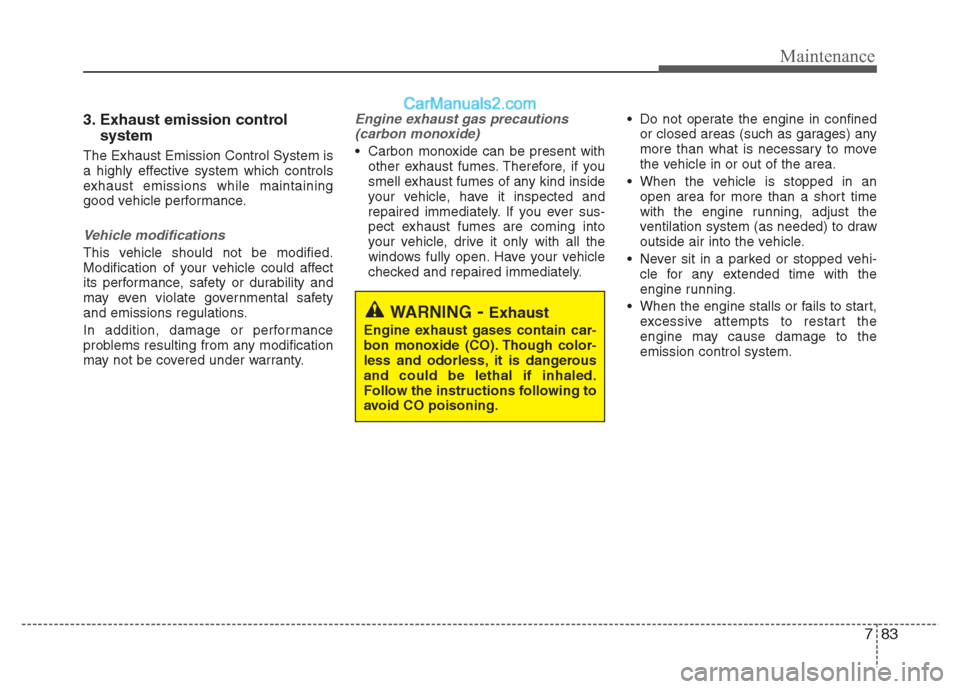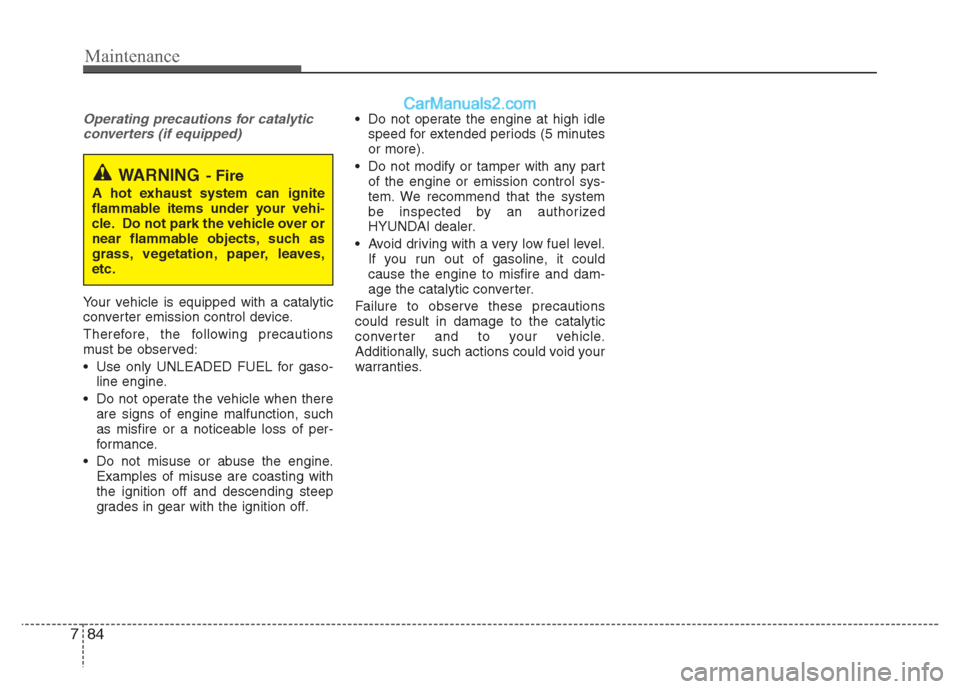Page 312 of 343
765
Maintenance
Engine compartment fuse panel
Inside the fuse/relay panel covers, you
can find the fuse/relay label describing
fuse/relay name and capacity.
✽✽NOTICE
Not all fuse panel descriptions in this
manual may be applicable to your vehi-
cle. It is accurate at the time of printing.
When you inspect the fuse panel in your
vehicle, refer to the fuse panel label.
OBA073014
OIA073033
Page 313 of 343
Maintenance
66
7
Engine compartment main fuse panel
Fuse Name Symbol Fuse rating Circuit Protected
MULTI FUSE
MDPS80A MDPS Unit
ALT125A (150A) Alternator, Fuse - F3 / F4 / F6, PCB Fuse & Relay Box
FUSE
B+4450A Smart Junction Box (Fuse : F1 / F2)
ESP 2230A ESP Control Module, Multipurpose Check Connector
ESP 1150A ESP Control Module
B+1150A Smart Junction Box (T/Sig Sound Relay, Fuse : F10, ARISU-LT1, IPS 3)
B+3340A Smart Junction Box (Power Window Relay, Fuse : F4, ARISU-LT2, IPS 5)
B+2250A Smart Junction Box (Fuse : F5 / F9 / F13 / F14 / F17, Leak Current Autocut Device
Fuse : F23 / F24 / F29)
IG140AW/O Button Start : Ignition Switch
With Button Start : PDM Relay Box (IG1 / ACC Relay)
FRT WIPER7.5A PCM, Front Wiper Motor, Multifunction Switch
BLOWER40A Blower Relay
ECU1E130A Engine Control Relay, Fuse : F25 / F26
Page 323 of 343

Maintenance
76
7
APPEARANCE CARE
Exterior care
Exterior general caution
It is very important to follow the label
directions when using any chemical
cleaner or polish. Read all warning andcaution statements that appear on thelabel.
Finish maintenance
Washing
To help protect your vehicle’s finish from
rust and deterioration, wash it thoroughlyand frequently at least once a month with
lukewarm or cold water.
If you use your vehicle for off-road driv-
ing, you should wash it after each off-
road trip. Pay special attention to the
removal of any accumulation of salt, dirt,
mud, and other foreign materials. Make
sure the drain holes in the lower edges of
the doors and rocker panels are keptclear and clean.
Insects, tar, tree sap, bird droppings,
industrial pollution and similar deposits
can damage your vehicle’s finish if not
removed immediately. Even prompt washing with plain water
may not completely remove all these
deposits. A mild soap, safe for use on
painted surfaces, may be used.
After washing, rinse the vehicle thor-
oughly with lukewarm or cold water. Do
not allow soap to dry on the finish.
WARNING -
Wet brakes
After washing the vehicle, test the
brakes while driving slowly to see if
they have been affected by water. If
braking performance is impaired,
dry the brakes by applying them
lightly while maintaining a slow for-
ward speed.
CAUTION
Do not use strong soap, chemical detergents or hot water, and do notwash the vehicle in direct sunlightor when the body of the vehicle iswarm.
CAUTION
Water washing in the engine com- partment including high pressure
water washing may cause the fail- ure of electrical circuits located inthe engine compartment.
Never allow water or other liquids to come in contact with electri-
cal/electronic components insidethe vehicle as this may damage them.
OJB037800
Page 329 of 343

Maintenance
82
7
EMISSION CONTROL SYSTEM
The emission control system of your
vehicle is covered by a written limited
warranty. Please see the warranty infor-
mation contained in the Service Passport
in your vehicle.
Your vehicle is equipped with an emis- sion control system to meet all emission
regulations. There are three emission control sys-
tems which are as follows.
(1) Crankcase emission control system
(2) Evaporative emission control system(3) Exhaust emission control system In order to assure the proper function of
the emission control systems, it is rec-
ommended that you have your vehicle
inspected and maintained by an author-
ized HYUNDAI dealer in accordance with
the maintenance schedule in this manu-al. Caution for the Inspection and
Maintenance Test (With Electronic
Stability Control (ESC) system)
To prevent the vehicle from misfir-
ing during dynamometer testing,
turn the Electronic Stability Control
(ESC) system off by pressing the
ESC switch.
After dynamometer testing is com- pleted, turn the ESC system back on
by pressing the ESC switch again.
1. Crankcase emission control system
The positive crankcase ventilation sys-
tem is employed to prevent air pollution
caused by blow-by gases being emitted
from the crankcase. This system supplies
fresh filtered air to the crankcase through
the air intake hose. Inside the crankcase,
the fresh air mixes with blow-by gases,
which then pass through the PCV valveinto the induction system. 2. Evaporative emission control
System
The Evaporative Emission Control
System is designed to prevent fuel
vapors from escaping into the atmos-
phere.
Canister
Fuel vapors generated inside the fuel tank are absorbed and stored in the
onboard canister. When the engine is
running, the fuel vapors absorbed in the
canister are drawn into the surge tank
through the purge control solenoid valve.
Purge Control Solenoid Valve (PCSV)
The purge control solenoid valve is con-
trolled by the Engine Control Module
(ECM); when the engine coolant temper-
ature is low during idling, the PCSV clos-
es so that evaporated fuel is not taken
into the engine. After the engine warms
up during ordinary driving, the PCSV
opens to introduce evaporated fuel to the
engine.
Page 330 of 343

783
Maintenance
3. Exhaust emission control system
The Exhaust Emission Control System is
a highly effective system which controls
exhaust emissions while maintaining
good vehicle performance.
Vehicle modifications
This vehicle should not be modified.
Modification of your vehicle could affect
its performance, safety or durability and
may even violate governmental safety
and emissions regulations.
In addition, damage or performance
problems resulting from any modification
may not be covered under warranty.
Engine exhaust gas precautions (carbon monoxide)
Carbon monoxide can be present with other exhaust fumes. Therefore, if you
smell exhaust fumes of any kind inside
your vehicle, have it inspected and
repaired immediately. If you ever sus-
pect exhaust fumes are coming into
your vehicle, drive it only with all the
windows fully open. Have your vehicle
checked and repaired immediately. Do not operate the engine in confined
or closed areas (such as garages) any
more than what is necessary to move
the vehicle in or out of the area.
When the vehicle is stopped in an open area for more than a short time
with the engine running, adjust the
ventilation system (as needed) to draw
outside air into the vehicle.
Never sit in a parked or stopped vehi- cle for any extended time with the
engine running.
When the engine stalls or fails to start, excessive attempts to restart the
engine may cause damage to theemission control system.
WARNING - Exhaust
Engine exhaust gases contain car-
bon monoxide (CO). Though color-
less and odorless, it is dangerousand could be lethal if inhaled.
Follow the instructions following to
avoid CO poisoning.
Page 331 of 343

Maintenance
84
7
Operating precautions for catalytic
converters (if equipped)
Your vehicle is equipped with a catalytic
converter emission control device.
Therefore, the following precautions
must be observed:
Use only UNLEADED FUEL for gaso- line engine.
Do not operate the vehicle when there are signs of engine malfunction, such
as misfire or a noticeable loss of per-
formance.
Do not misuse or abuse the engine. Examples of misuse are coasting withthe ignition off and descending steep
grades in gear with the ignition off. Do not operate the engine at high idle
speed for extended periods (5 minutesor more).
Do not modify or tamper with any part of the engine or emission control sys-
tem. We recommend that the system
be inspected by an authorized
HYUNDAI dealer.
Avoid driving with a very low fuel level. If you run out of gasoline, it couldcause the engine to misfire and dam-
age the catalytic converter.
Failure to observe these precautionscould result in damage to the catalytic
converter and to your vehicle.
Additionally, such actions could void your
warranties.
WARNING - Fire
A hot exhaust system can ignite
flammable items under your vehi-
cle. Do not park the vehicle over or
near flammable objects, such as
grass, vegetation, paper, leaves,etc.
Page 332 of 343
Specifications & Consumer information
DIMENSIONS . . . . . . . . . . . . . . . . . . . . . . . . . . . . . . . . . . 8-2
ENGINE . . . . . . . . . . . . . . . . . . . . . . . . . . . . . . . . . . . . . . . 8-2
BULB WATTAGE. . . . . . . . . . . . . . . . . . . . . . . . . . . . . . . . 8-2
TIRES AND WHEELS . . . . . . . . . . . . . . . . . . . . . . . . . . . 8-3
RECOMMENDED LUBRICANTS AND
CAPACITIES . . . . . . . . . . . . . . . . . . . . . . . . . . . . . . . . . . . 8-4• Recommended SAE viscosity number . . . . . . . . . . . 8-5
VEHICLE IDENTIFICATION NUMBER (VIN). . . . . . 8-6
VEHICLE CERTIFICATION LABEL . . . . . . . . . . . . . . 8-6
TIRE SPECIFICATION AND PRESSURE LABEL . . . 8-7
ENGINE NUMBER . . . . . . . . . . . . . . . . . . . . . . . . . . . . . . 8-7
AIR CONDITIONER COMPRESSOR LABEL . . . . . . 8-7
8
Page 333 of 343
BULB WATTAGE
Specifications & Consumer information
2
8
DIMENSIONS
* : If equipped
*
1
: 4 Door
* 2
: 5 Door Light Bulb Wattage
Front Headlights (High/Low) 60/55
Front turn signal light 21
Parking(Position) light 5
Front fog light* 35
Side repeater light* 5
Daytime running light* 21
Rear Stop and tail light 21/5
Back-up light 16
Rear turn signal light 21
Rear fog light* 21
High mounted stop light* 5
Interior License plate light 5
Room lamp 8
Luggage room lamp* 8
Glove box lamp* 5
ENGINE
Item 1.0 Kappa 1.2 Kappa
Displacement cc (cu. in) 997 (60.8) 1,248 (76.2)
Bore x Stroke mm (in.)71.0x84.0
(2.8x3.3) 71.0x78.8
(2.8x3.1)
Firing order 1-2-3 1-3-2-4
No. of cylinders 3 4
Item mm (in)
Overall length 3995 (157.3)* 1
/3765 (148.2)* 2
Overall width 1660 (65.4)* 1
*2
Overall height 1520 (59.8)* 1
*2
Front tread 1479 (58.2) Rear tread 1493 (58.8)
Wheelbase 2425 (95.5)* 1
*2